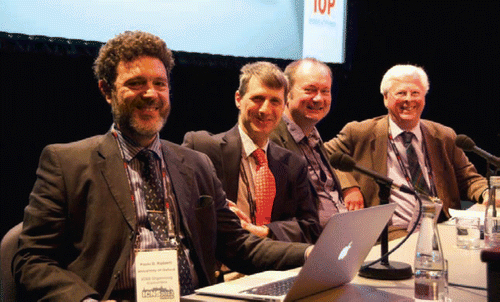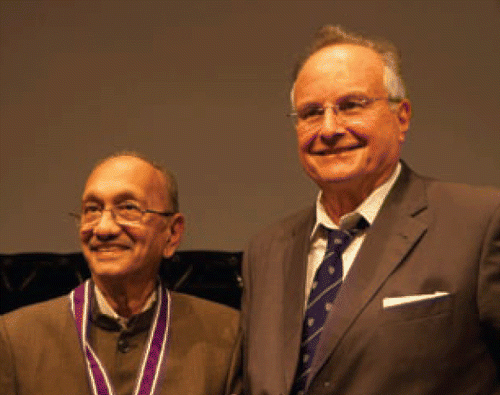The International Conference on Neutron Scattering (ICNS) took place from 8–12 July 2013 in Edinburgh, Scotland. This was the 9th conference of this well-established series. ICNS2013 brought together approximately 800 scientists from 34 different countries who took the opportunity to present high-quality science and to discuss and develop ideas for exciting new work.
The conference was universally acknowledged to have been a great success. The venue was the Edinburgh International Conference Centre, ideally located close to many hotels and restaurants. Throughout the week, the weather was astonishingly good with the sun shining until the sunset after 22:00 (the latitude of Edinburgh is 56 degrees north), so that the umbrellas supplied in the delegate bags remained unused.
Welcome to Edinburgh and to ICNS
In the opening ceremony, the organizing committee constituted by Keith McEwen (University College London), Paul Attfield (University of Edinburgh), Jon Goff (Royal Holloway, University of London), and Paolo Radaelli (University of Oxford) welcomed everyone to the lovely city of Edinburgh, listed as a UNESCO World Heritage Site. Adding a taste of history, Andrew Harrison, Science Director at the Institut Laue-Langevin (ILL), told us about the important contributions of Scotland and its universities to the scientific world.
The opening session was also the appropriate occasion to announce exciting events in the neutron world such as the launch of the worldwide internet platform neutronsources.org (see the news in this issue) and the recently established Sample Environment Society.
The committee invited everyone to visit the over 50 exhibitors present at ICNS2013. These included a number of worldwide research facilities, projects and companies providing a variety of fundamental materials, who have shared interesting information such as posters and brochures with their results, the range of instruments offered, and other neutron-related products. At the NMI3 stand, participants could take part in a neutron-geographical competition to win books on neutron scattering. To be eligible, they were requested to place the project facilities' logos in the right place on a map. Thanks to the sponsorship of the exhibitors, the conference fees could be kept at a reasonable price, which is very important especially for students.
High Quality Science
Many talks and posters were presented at ICNS2013 on a wide variety of fields where neutrons are triggering important scientific discoveries. To mention just a few, the sessions addressed issues such as the structure of diverse materials, cultural heritage, magnetism, instruments, biology, geosciences, and energy, including interesting presentations and plenary talks by researchers and scholars from universities and research centres around the globe. During the poster sessions and coffee breaks the corridors of the Edinburgh International Conference Centre carried a vibrant atmosphere where the participants took part in interesting discussions.
Aside from the conference, delegates could also participate in nine workshops and satellite meetings organised to foster understanding on techniques and instruments, and also to provide space for brainstorming about new collaborations and projects. These meetings and workshops addressed not only scientific topics such as neutron optics, detectors, polarised neutrons, dynamics, resonant elastic X-ray scattering, magnetism, and neutron scattering at extreme conditions, but they were also an opportunity to discuss the future of the European Spallation Source (ESS), the impact of neutron research and how to disseminate it, as well as ways of enhancing collaboration between research facilities and industry.
Prizes Ceremony
Neutron scientists worldwide achieve important results everyday contributing to fundamental developments in a myriad of fields such as energy, medicine, arts, agriculture and many others. For this reason, it is worthwhile to award those who are dedicating their work to the development of science. The organising committee and the session chairs selected a total of 17 posters, considered the best ones presented at ICNS2013, for prizes sponsored by the UK Science and Technology Facilities Council. And because the future of neutron research depends on the next generation of scientists, the International Union of Crystallography (IUCr) awarded the “Young Scientists Prize” to Elisa Wheeler from ILL for her work on “Probing the magnetic excitations of frustrated spinels,” which was considered the best piece of research underpinned by crystallography.
The “AONSA Prize” recognises outstanding research careers with a significant impact or contribution to the use or development of neutron science or technology in the Asia-Oceania Region. This year the prize was awarded to Balebail Anantha Dasannacharya, retired from the Bhabha Atomic Research Centre in India, “for his pioneering contributions to neutron scattering in the Asia-Oceania region, through his early development of neutron spectroscopy and its applications for the dynamics in low-temperature liquids and molecular solids, and his active promotion of regional and international science as well as the national user program in India.” The ICNS was the perfect occasion to offer this prize because Dasannacharya could tell us about the history and status of neutron scattering in India and the Asia-Oceania Region since he started his career in 1958, and also share his own experience and interesting results.
The European Neutron Scattering Association (ENSA) also took the opportunity to present two prizes in Edinburgh. Together with the European Crystallographic Association (ECA), it awarded the Erwin Felix Lewy Bertaut Prize to Johan Chang from the École Polytechnique Fédérale de Lausanne, Switzerland, “in recognition of his outstanding contributions to the quest for understanding cuprate superconductors.” As for the Walter Hälg Prize, it was awarded to Joe Zaccai from the Centre National de la Recherche Scientifique (CNRS), France, “in recognition of his pioneering contributions to the application of neutron scattering to a range of biophysical and biochemical problems in biology, which has provided important insights in the debate on the relationship between molecular structure and dynamics and biological function, and for his leading advocacy of the role of neutron scattering in biological research.” At ICNS, he gave a talk on “Neutrons and Life with a Pinch of Salt” where he exposed the relationship between biology and neutron scattering and the efforts made by a number of scientists to strengthen the bonds between these two worlds.
Social Programme
The organizers arranged an excellent social program, with the opening reception on the Monday evening at Our Dynamic Earth where the Lord Provost of Edinburgh (the Mayor) welcomed delegates to the city. On the Wednesday evening, a reception at Edinburgh Castle allowed the participants to explore this great landmark and see the Scottish Crown Jewels. In a break with convention, the conference dinner was held on the Friday evening, allowing a full scientific program on the last day of the conference. The dinner was held in the splendid Victorian gothic setting of the National Museum of Scotland, and was followed by dancing to a céilidh band led by an Edinburgh chemistry postdoc.
Closing Session
The organizers of ICNS2013 tested a number of innovations that they adopted in order to provide a better experience to the participants. The conference website was very comprehensive; for the first time there was an app with the conference program and useful information that could be downloaded and used on mobile devices; there were no proceedings so that the scientists are now able to submit their high-quality papers to scientific journals; staggered invited talks allowed participants to attend all the talks they wished; and finally, as noted above, the conference dinner took place on the last evening to make it possible for a full programme until the last day.
The neutron world will continue to produce valuable results worth presenting and discussing. For this reason, the next international conferences are already planned and were announced in the closing session. The Spanish Neutron Scattering Community (SETN) will host the next European Conference on Neutron Scattering (ECNS). It will be between August 30th and September 4th 2015 in Zaragoza, Spain. As for the next ICNS, it will be held in July 2017 in Daejeon, Korea. The conference will take place at the Daejeon Convention Centre, a “science town” centre of advanced science and technology. The Korea Atomic Energy Research Institute (KAERI) and the Korean Neutron Beam Users Association (KNBUA) invite everyone to attend. Everyone's active participation is fundamental to continue the success of these series of conferences!
To close the conference, Keith McEwen thanked his colleagues from the Organising Committee, together with the members of the Programme and International Advisory Committees, the assistants from the local Universities, and of course all the participants. Finally, he thanked the team from the Institute of Physics who had looked after all the administrative and financial aspects of the conference. This was undoubtedly a successful week of valuable exchange of ideas and cultures, as we could taste the traditional Scottish haggis and whisky. The most important point remains that ICNS2013 was the best occasion to meet in person the people who we often exchange emails with, as it accidentally happened to Hannu Mutka and Inês on the way from the airport. The outcome is this meeting report!

